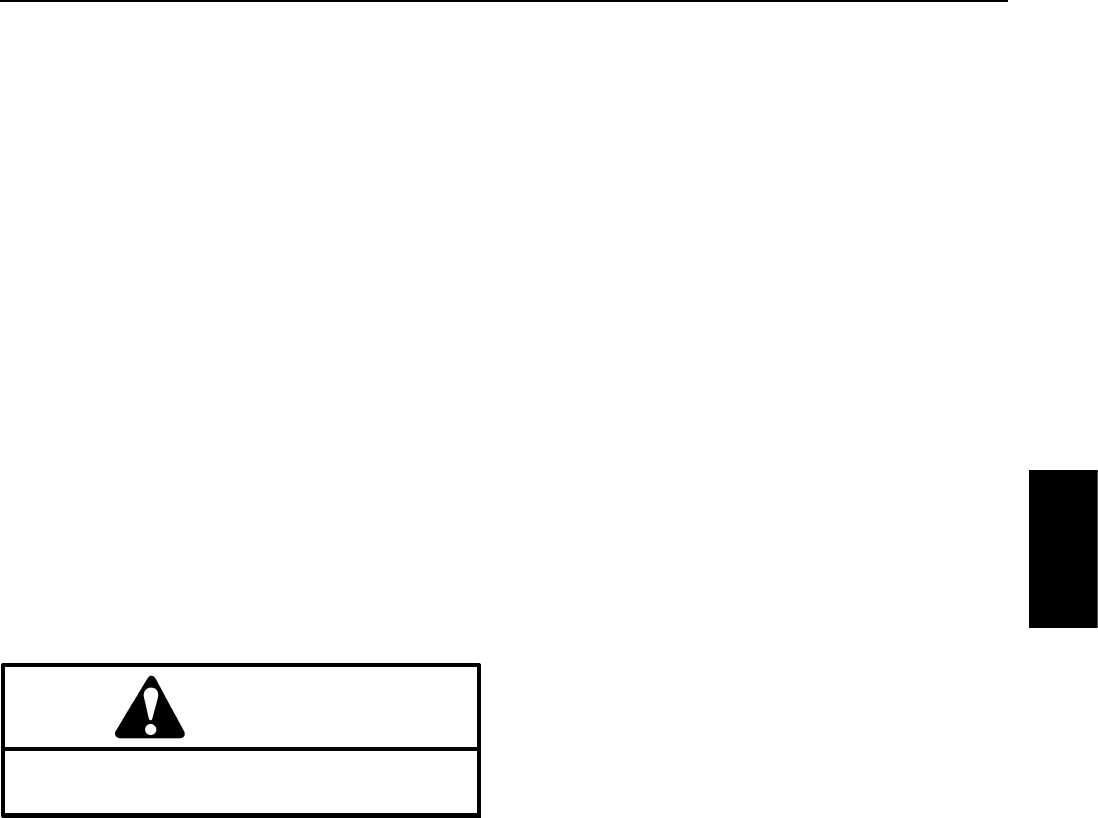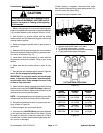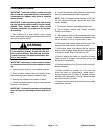
Groundsmaster 4500--D/4700--D Hydraulic SystemPage 4 -- 77
Charge Hydraulic System
NOTE: When initially starting the hydraulic system with
new or rebuilt components such as pumps, motors or lift
cylinders, it is important that the hydraulic system be
charged properly. Air must be purged from the system
and its components to reduce the chance of damage.
IMPORTANT: Change hydraulic oil filter whenever
hydraulic components are repaired or replaced.
1. Park machine on a level surface. Lower cutting
decks, stop engine and engage parking brake. Remove
key from the ignition switch.
2. Make sure all hydraulic connections, lines and com-
ponents are secured tightly.
3. If component failure wassevere or thesystem is con-
taminated, flush and refill hydraulic system and reser-
voir (see Flush Hydraulic System in this section).
4. Make sure hydraulic reservoir is full. Add correct hy-
draulic oil if necessary.
5. Prime hydraulic pumps (see Priming Hydraulic
Pumps in this section).
WARNING
Before jacking upt he machine, review and follow
Jacking Instructions in Chapter 1 -- Safety.
6. Raise one front and one rear wheel off the ground
and place appropriate jack stands under the frame to
support machine. Chock remaining wheels to prevent
movement of the machine.
IMPORTANT: During initial operation, check hy-
draulic reservoir oil level frequently and add oil as
necessary.
7. Make sure traction pedal is in neutral. Start engine
and run it at low idle speed. The hydraulic pumps should
pick up oil and fill the hydraulic system. If there is no in-
dication of fill in 30 seconds, stop the engine and deter-
mine the cause.
8. After the hydraulic system starts to show signs of fill,
actuate lift control switch until the lift cylinders move in
and out several times. If the cylinders do not move after
15 seconds or the pump emits abnormal sounds, shut
the engine off immediately and determine cause or
problem. Inspect for the following:
A. Loose hydraulic filter or suction lines.
B. Blocked suction line.
C. Faulty charge relief valve in traction pump.
D. Faulty gear pump.
9. Once lift cylinders do move, proceed to step 10.
10.Operate the traction pedal inthe forward and reverse
directions. The wheels off the ground should rotate in
the proper direction.
A. If the wheels r otate in the wrong direction, stop
engine and inspect hydraulic line placement at pis-
ton (traction) pump and wheel motors. Correct hy-
draulic line installation before proceeding.
B. If the wheels rotate in the proper direction, pro-
ceed to step 11.
11.Make sure that traction pedal returns to the neutral
position when released from the forward or reverse dir-
ection.
12.Check operation of the traction interlock switch.
13.Stop engine, remove jack stands from frame and
lower machine. Removechocks from remaining wheels.
14.If the piston (traction) pump or a traction motor was
replaced or rebuilt, run the machine so all wheels turn
slowly for ten (10) minutes.
15.Operate machine by gradually increasing its work
load to full over a ten (10) minute period.
16.Stop the machine. Check hydraulic reservoir and fill
if necessary. Check hydraulic components for leaks and
tighten any loose connections.
Hydraulic
System


















